Review by Pete Vack
Maserati 300S by Walter Bäumer
295 mm x 290mm, 360 pages, 390 historical black and white and color, case bound with dust jacket and slip case. Price, $155 USD ON SALE NOW FOR $116 and Free US Shipping!
To Order email vack@cox.net
Walter Bäumer’s new book on Maserati A6G Zagatos will be available soon from Dalton Watson.
The most dog eared books (the ones most referred to and therefore cherished) we have in our office library are those with the little numbers and big pictures (both literally and figuratively).
And then there is Walter Bäumer, a historian and consultant for classic Maseratis with a will, passion and ability to hunt down the twenty eight known Maserati 300S sport racers. Bäumer has done a compelling, interesting job and assembled a great number of previously unpublished photos; his book is also the first to present the complete history of the 300S. In the opinion of many, the 300S itself was best all around sport racing car of the 1950s, Ferrari be damned. A veritable 250F with mudguards, the 300S was the favorite of Moss, Fangio, Behra, and many other lesser lights. The combination of the two, Bäumer and the 300S, while not quite magic, is most certainly worth the paltry $116 charged by Dalton Watson for the pleasure of adding this to your shelf. It will be, and in fact already is, one of our favorite dog eared books.
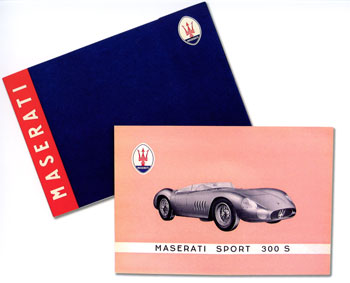
As should be expected in such a work, included in each of the chapters, approximately one per serial number, are the list of known races in which the car participated, a rundown of each significant event, identifying features and most owners to the present day.
The Maserati 300S goes the extra mile, including in the text interesting and informational chapters. Bäumer provides a full technical description, a breakdown of the physical changes of the cars, a full chapter on numbers and numbering system for the chassis, engine and internal serial numbers, and illustrates the sales and ads featuring the 300S. He provides a competition background, discussing the racing activities in Europe, Italy and the U.S. He lists the surprising number of “Mystery Cars” discusses the rare 350S, and provides copies of the 300S owner’s manual. Finally, Bäumer provides a chapter about the personalities associated with the era of the 300S and includes figures such as “Mimmo” Dei, the man behind the famous Centro Sud racing team.
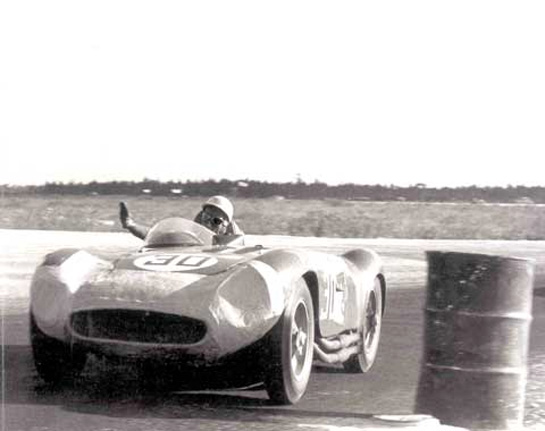
Moss driving the battered 300S owned by Bill Lloyd to victory in the Bahamas in 1956. Courtesy Walter Bäumer.
We must also mention that the 390 historical photographs are large, fresh, and thoroughly enjoyable. If there is any complaint here it is that some of the original photos were enlarged perhaps too large and lose some focus and quality. This is offset by the stunning original color photos that are liberally sprinkled through the book. Bäumer has made good use of his relationship with the Cahier family—just thumbing through the book one notices the really excellent photographs are inevitably by the late Bernard Cahier. Good photos need good paper–in this case 170gsm Stora Enso Matt Art, 295 by 290 mm in size. That’s an excellent, semi gloss heavy paper which allows the historical photos to be to presented in the best light.
SUPPORT VELOCETODAY BY BECOMING A PREMIUM SUBSCRIBER
The Maserati 300S was a favorite choice of the cognoscenti; Briggs Cunningham ordered the first three built; chassis 3051, 3052 and 3053. The new Maserati immediately made its mark. 3051, raced and possibly actually owned by Bill Lloyd, entered its first race at Thompson, in Connecticut, on May 1, 1955, winning the first time out. Lloyd campaigned the car throughout the 1955 and 1956 SCCA season, with good results. At the end of 1956, he entered 3051 at the Bahamas Speed Weeks, bashed the nose in one race and handed the battered Maserati over to Stirling Moss for the feature, which Moss won.
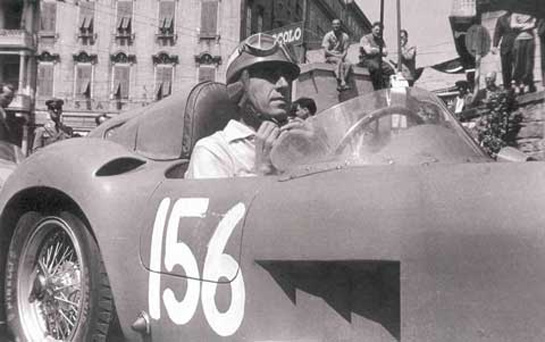
Privateer and Maserati customer Franco Bordini presents the quintessential image of the 1950s Italian race driver. Courtesy Walter Bäumer.
As Bäumer finds, a number of the 300S cars were built specifically for the factory team, but were often lent to privateers at times for a variety of reasons, most of which having to do with money, which was always short.
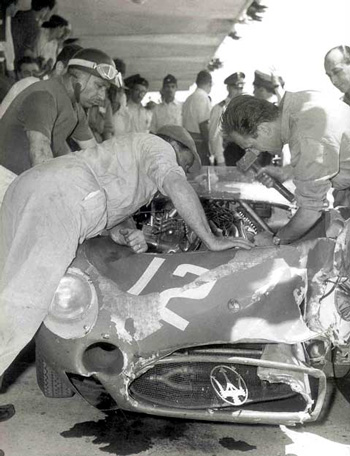
Rarely seen mistakes of the master. Fangio looks over the damage he has wrought on Godia-Sales 300S. Courtesy Walter Bäumer.
Chassis 3055 was a factory car, in which Jean Behra took to a win at Bari, Italy, in May of 1955; Perdisa and Mieres took third with the car at Monza and Musso and Valenzano used the car at LeMans in June but DNF’d. Then, privateer and good customer Franco Bordini borrowed 3055 for a hill climb and took first place. By November the car was back with the factory and Luigi Musso drove it at Caracas but again did not finish. Needless to say, the very Italianate life of a racing Maserati made Bäumer’s job tracking each car somewhat miserable.
The life of chassis 3066 followed a similar pattern, a factory works chassis delivered to Francisco Godia-Sales, a good, solid amateur driver who also owned and raced a 250F. The new owner raced the car throughout the 1956 season on his own, but at Sweden in August, 3066 was appropriated for the team and Godia-Sales co-drove with Joakim Bonnier. In January of 1958, the Godia-Sales 300S made an appearance at the 1000Km of Buenos Aires, and in the hands of Juan Fangio it suffered moderate damage–a result of one of Fangio’s rare mistakes. Godia-Sales was reputed to have remarked that “to crash the car, I wouldn’t have needed Fangio!”
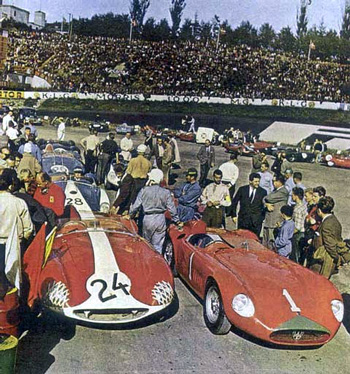
On of the many of the era color shots in the 300S book—note the orange/red color of the Maserati paint. Courtesy Walter Bäumer.
Another problem chassis detectives must solve is the confusion resulting as a result of a chassis being re-numbered by the factory and then resold. Chassis 3080 was a bit of a mystery at the beginning, but Bäumer tracked it down to a car used by Stirling Moss at Oporto in 1958, and borrowed again by Moss for a series of races held in Sweden and Copenhagen later that year. At that point, 3080 was returned to Modena, apparently renumbered as 3083, and sold to the U.S. Maserati dealer in Long Island. In 1971 the same car appeared in an ad which claimed it had only 2000 miles and had never been raced.
The most tantalizing part of the book deals with the dozen mystery cars that appeared in races but lack a positive id. Many may still be lying in a shed, (probably in South America, where a large percentage found a home late in life). Bäumer lays out the evidence, tries to put the pieces of the puzzle together, and hopes that in publishing the book, some of the mysteries will be solved.
While happily tromping through the many pages of Bäumer’s book, we noted a few niggling errors but none serious enough to make light of. Maserati historians, known at times to be pretty critical, will probably find something objectionable between the covers, but that is how things are learned and facts corrected. The book is not the last word on the subject, but it will be some years before another attempt is made to chronicle the history of the 300S.
With Christmas just around the corner, make sure you put this book on your list of things you can’t live without.
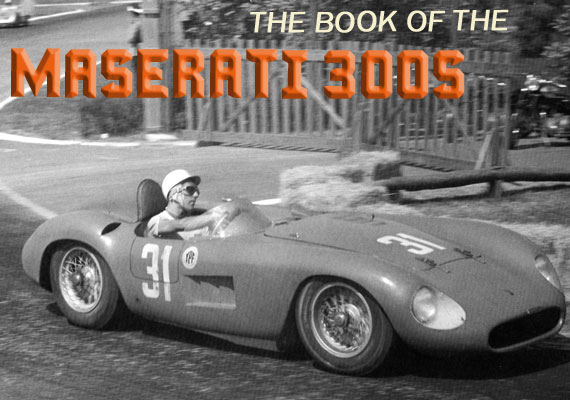
Worked for Joe Giubardo who owned chassis 3053 and raced it locally at Lime Rock Bridgehampton etc.